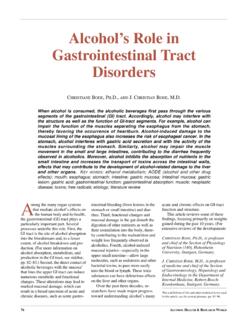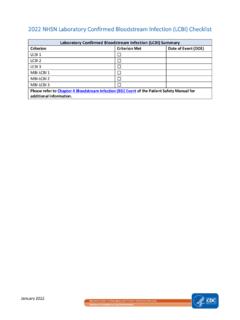Transcription of 2017 Updated Recommendations on the Use of Chlorhexidine ...
1 Last update: July 17, 2017 Page 1 of 15 2017 Updated Recommendations on the Use of Chlorhexidine -Impregnated Dressings for Prevention of Intravascular Catheter- related Infections Centers for Disease Control and Prevention National Center for Zoonotic and Emerging Infectious Diseases Division of Healthcare Quality Promotion Thomas R. Talbot III, MD, MPHa, Erin C. Stone, MAb, Kathleen Irwin, MD, MPHb, Amanda D. Overholt, MPHc, Mahnaz Dasti, MPHd, Alexander Kallen, MD, MPHb, , for the Healthcare Infection Control Practices Advisory Committeee a Vanderbilt University School of Medicine, Vanderbilt University Medical Center, b Division of Healthcare Quality Promotion, National Center for Emerging and Zoonotic Infectious Diseases, Centers for Disease Control and Prevention, c Northrop Grumman Corporation, d Time Solutions LLC, and e Contributing HICPAC Members Suggested citation: Centers for Disease Control and Prevention.
2 2017 Recommendations on use of Chlorhexidine -impregnated dressings for prevention of intravascular catheter- related infections: An update to the 2011 guidelines for the prevention of intravascular catheter- related infections from the Centers for Disease Control and Prevention. Centers for Disease Control and Prevention, National Center for Emerging and Zoonotic Infectious Diseases, Division of Healthcare Quality and Promotion. DATE. (DHQP website URL to be added) Disclosures and disclaimers: The authors report no actual or potential conflicts of interest related to the commercial products discussed herein. This document is not protected by the Copyright Act, and copyright ownership cannot be transferred. It may be used and reprinted without special permission. Accessible version: Updated Recommendations on the Use of Chlorhexidine -Impregnated Dressings for Prevention of Intravascular Catheter- related Infections (2017) Last update.
3 July 17, 2017 Page 2 of 15 Abbreviations Abbreviation Definition BSI bloodstream infection CABSI catheter-associated bloodstream infection CDC Centers for Disease Control and Prevention CHG Chlorhexidine gluconate C-I Chlorhexidine -impregnated CLABSI central line-associated bloodstream infection CMS Centers for Medicare & Medicaid Services CRBSI catheter- related bloodstream infection CRI catheter- related infections CVC central venous catheter FDA Food and Drug Administration GRADE Grading of Recommendations Assessment, Development and Evaluation HICPAC Healthcare Infection Control Practices Advisory Committee ICU intensive care unit IV intravenous MSB maximal sterile barrier precautions NICU neonatal intensive care unit PICU pediatric intensive care unit PCICU pediatric cardiac intensive care unit RCT randomized controlled trial SR systematic review Updated Recommendations on the Use of Chlorhexidine -Impregnated Dressings for Prevention of Intravascular Catheter- related Infections (2017) Last update: July 17, 2017 Page 3 of 15 Table of Contents Abbreviations.
4 2 Table of Contents ..3 List of Tables and Figures ..3 Summary ..4 Recommendations ..4 Background ..5 Methods ..5 Figure 1: Yield of Systematic Search of Articles Published January 2010 March 6, 2017 ..6 Table 1. Categorization Scheme for Recommendations21,22 ..7 Evidence Summary ..7 Patients Aged 18 Years and Older ..7 Dressings and skin antisepsis ..7 Catheter- related bloodstream infection ..8 Catheter- related infection ..8 Product- related adverse events ..8 Chlorhexidine Limitations of the evidence ..9 Patients Younger Than 18 Years ..10 Dressings and skin antisepsis ..10 Catheter- related bloodstream infection ..10 Catheter-associated bloodstream infection ..10 bloodstream infection without a source ..11 Local catheter infection ..11 Product- related adverse events ..11 Chlorhexidine Limitations of the evidence ..11 Implementation Considerations for Patients aged 18 Years and Older.
5 12 References ..13 Contributors ..15 Staff and contractors of the Centers for Disease Control and Prevention ..15 Healthcare Infection Control Practices Advisory Committee (HICPAC) ..15 List of Tables and Figures Tables: Table 1: Categorization Scheme for Recommendations Figures: Figure 1: Yield of Systematic Search of Articles Published January 2010 March 2017 Updated Recommendations on the Use of Chlorhexidine -Impregnated Dressings for Prevention of Intravascular Catheter- related Infections (2017) Last update: July 17, 2017 Page 4 of 15 Summary In 2011, the Centers for Disease Control and Prevention (CDC) and CDC s Healthcare Infection Control Practices Advisory Committee (HICPAC) issued Guidelines for the Prevention of Intravascular Catheter- related This document (hereafter called the 2011 Guidelines) included two Recommendations about the use of Chlorhexidine -impregnated (C-I) dressings, along with other strategies included in multicomponent interventions ( bundles ) to prevent intravascular catheter- related infections.
6 By 2017, additional evidence had emerged regarding the benefits and harms of one or more of these types of dressings for use with intravenous (IV) catheters, central venous catheters (CVCs), and arterial ,3 The Food and Drug Administration (FDA) has cleared C-I dressings based on bench testing data, demonstrating effectiveness of the device as a barrier to bacterial penetration to the catheter site, and the effectiveness of Chlorhexidine in the reduction of bioburden within the dressing during use. The FDA has cleared a subset of these dressings with the specific indication for preventing catheter- related blood stream infection (CRBSI) based on results from clinical testing This document provides evidence-based Recommendations on the use of C-I dressings that update selected Recommendations from the 2011 Guidelines. These Recommendations are based on: 1) a systematic review of literature published in English from January 1, 2010 through March 6, 2017; 2) a systematic grading of the quality of evidence5- 7 ( Appendix Table 4 and Appendix Table 5); 3) input from infection prevention experts at CDC and HICPAC; and 4) input from the public.
7 Prior to finalizing the Recommendations , CDC solicited input from HICPAC and the public on the draft Recommendations , reviewed these comments, incorporated relevant changes, and sought final HICPAC input at a public teleconference on May 5, 2017, during which HICPAC unanimously voted to approve the Updated Recommendations . Recommendations 1. For patients aged 18 years and older: a. Chlorhexidine -impregnated dressings with an FDA-cleared label that specifies a clinical indication for reducing catheter- related bloodstream infection (CRBSI) or catheter-associated blood stream infection (CABSI) are recommended to protect the insertion site of short-term, non-tunneled central venous catheters. (Category IA)8- 12 ( See Section Implementation Considerations for Patients Aged 18 Years and Older). 2. For patients younger than 18 years: a. Chlorhexidine -impregnated dressings are NOT recommended to protect the site of short-term, non-tunneled central venous catheters for premature neonates due to risk of serious adverse skin reactions.
8 (Category IC)13,14 b. No recommendation can be made about the use of Chlorhexidine -impregnated dressings to protect the site of short-term, non-tunneled central venous catheters for pediatric patients less than 18 years old and non-premature neonates due to the lack of sufficient evidence from published, high-quality studies about efficacy and safety in this age group. ( unresolved issue)14,15 These Recommendations supersede only the two statements about C -I dressings in the section on Catheter Site Dressing Regimens ( Recommendations 12 and 13) in the 2011 Guidelines. The Updated Recommendations on use of C-I dressings for short-term, non-tunneled CVCs do not supersede other Recommendations about tunneled CVCs, peripheral intravenous catheters, arterial catheters, and other topics covered in the 2011 Guidelines. Updated Recommendations on the Use of Chlorhexidine -Impregnated Dressings for Prevention of Intravascular Catheter- related Infections (2017) Last update: July 17, 2017 Page 5 of 15 Background In 2011, CDC and HICPAC released Guidelines for the Prevention of Intravascular Catheter- related Infections1 that included two Recommendations for C-I dressings: Use a Chlorhexidine -impregnated sponge dressing for temporary short-term catheters in patients older than 2 months of age if the central line-associated bloodstream infection (CLABSI) rate is not decreasing despite adherence to basic prevention measures, including education and training, appropriate use of Chlorhexidine for skin antisepsis, and maximal sterile barrier precautions (MSB)12-14,16 ( Category 1B.)
9 Defined in 2011 as strongly recommended for implementation and supported by some experimental, clinical, or epidemiologic studies and a strong theoretical rationale; or an accepted practice [ , aseptic technique] supported by limited evidence). No recommendation is made for other types of Chlorhexidine dressings (unresolved issue: defined in 2011 as represents an unresolved issue for which evidence is insufficient or no consensus regarding efficacy exists). The 2011 Recommendations were based on published evidence from the date of the first indexed article in the database through December 2009. The evidence consisted of randomized controlled trials (RCTs) and systematic reviews (SRs) that examined C-I sponge dressings, but not other types of C-I dressings. Between January 2010 and March 2017, new evidence accrued, including: 1. two RCTs that examined C-I sponge dressings8 or C -I gel dressings11 2. two meta-analyses17,18 of these two types of C-I dressings evaluated as a single product class 3.
10 A professional association s compendium of strategies for the prevention of CLABSI19 ( CDC experts participated in the development of this document, which contains a section that evaluated two different C-I dressings as a single product class). Methods CDC developed the following key question using the PICO ( Patient, Intervention, Comparator, Outcome) format to guide the search of published literature on C -I dressings in adults (defined as patients aged 18 years and older) and children (defined as patients younger than 18 years).5 1. Does use of C -I dressings, compared with use of standard dressings, affect the risk of intravascular infections associated with short-term, non-tunneled central venous catheters in adults and children? CDC conducted a systematic review of the best available evidence on C-I dressings. CDC then used a modification of the Grading of Recommendations Assessment, Development and Evaluation (GRADE) method to assess the quality of the available evidence, to determine the strength of Recommendations , and to show the relation between evidence and ,7,20 Two reviewers ( Dasti, Overholt) systematically searched articles indexed in MEDLINE and the Cochrane Library for articles published through March 6, 2017 (Appendix Table 1, Appendix Table 2, and Appendix Table 3).


















